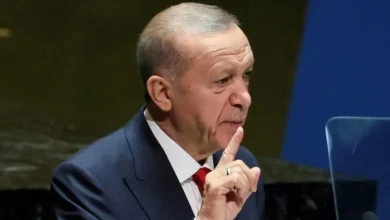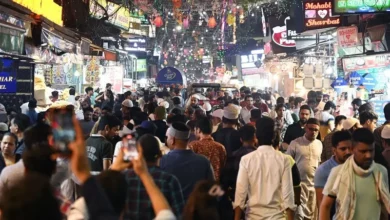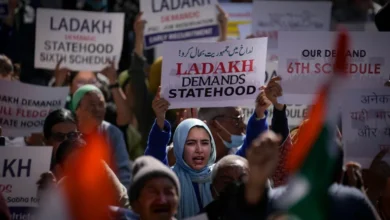Why Myanmar’s opposition is calling for a ban on jet fuel

When the Myanmar military helicopters opened fire, first-graders Phone Tay Za and his cousin, Lin Lin, rushed to take cover behind a tamarind tree in their schoolyard, located on the grounds of a monastery, in Let Yat Kone village in the central Sagaing region.
It was just after noon on September 16. The children had been squeezing in their last few minutes of play before class.
The gunfire from the helicopters continued for nearly an hour, according to witnesses, and at one-point Phone Tay Za decided to retrieve his bag from his classroom.
The seven-year-old reached the bag but was hit as he tried to run back.
“He called me from where he was lying in a pool of blood … ‘come and take me, I’m hurt’,” Lin Lin, who survived the attack, told the Irrawaddy news website.
“I had warned him not to go get the bag.”
A teacher at the school told the Radio Free Asia broadcaster that when she saw Phone Tay Za, “his arm was missing and there were holes in his feet”. The boy’s mother arrived at the scene soon afterwards. “He was saying over and over ‘Mother, I am in so much pain. I just want to die’,” the teacher said.
Phone Tay Za was among seven children killed in Let Yet Kone that day. Six adults also died.
Myanmar’s military described the school as a legitimate target. Since it seized power in a coup two years ago, the military has been fighting a range of groups opposed to its rule, including ethnic armed organisations, civilian militias known as People’s Defence Forces (PDFs) and an administration of the elected politicians it removed called the National Unity Government (NUG). It said PDFs and the rebel Kachin Independence Army (KIA), who it labelled “terrorists”, were using the school building to attack its forces.
But investigators from the United Nations said the air raid could amount to a “war crime”.
According to UN figures, the Let Yet Kone raid was one among at least 670 air attacks carried out by the Myanmar military last year – a number that marks a 12-fold increase from the 54 aerial assaults recorded the year before.
Other raids include the bombing of a rebel training camp, which killed five fighters in Chin state on the Indian border in January, and an air raid on a music concert in KIA territory in October, which killed some 80 people.
A Myanmar fighter jet on a bombing mission on the Thai border in June last year, meanwhile, prompted panic in Thailand when it crossed the frontier, with officials ordering the evacuation of villages and schools in the area.
At least 460 people died in last year’s raids, according to Irrawaddy, while the two-year conflict has killed an estimated 31,022 people in total – civilians and combatants alike – according to the Armed Conflict Location and Event Data Project (ACLED).
The UN estimates that a further 1.1 million people have had to flee their homes, mainly because of the bombing raids.
As the toll rises, the NUG and human rights campaigners have called for a total ban on sales of jet fuel to Myanmar, even if that means the grounding of civilian flights, too. The NUG, in a statement following the bombing of the Chin rebel camp in January, called the ban “an urgent and necessary step that potentially will save thousands of lives”.
‘Increased terror’
As the military has amped up its air campaign, its air force has been flying sorties every two weeks or so, said Zachary Abuza, a professor of Southeast Asian politics at the National War College in the United States.
The military relies on a range of aircraft for these missions, he said, including Yak-130 trainer aircraft and some 30 MIG-29 fighter jets from Russia. Most recently, it imported two of the more advanced SU-30 fighter jets, also from Russia, and has brought in long-range artillery, including mobile howitzers and multiple launch rocket systems, from China.
“These will give the military long-range strike capability. They can now attack from a distance with a degree of safety now, that they simply could not before,” said Abuza. “And right now, the NUG has no way to counter this – not easily. And [the air raids] do have a psychological effect there. They do kill people. They do increase the degree of terror.”
Still, the increase in aerial raids suggests “weakness”, Abuza told Al Jazeera. “It’s a tacit acknowledgement that they cannot always deploy boots on the ground. That simply there are a lot of no-go zones, where they do not have sufficient manpower to go in and fight and win.”
Indeed, the UN Special Rapporteur on Human Rights in Myanmar, Tom Andrews, estimates that two years on from the coup, the military controls “substantially less than half of Myanmar”.
Since Senior General Min Aung Hlaing’s power grab on February 1, 2021, Myanmar’s various ethnic armed groups – many of whom have fought the military on and off in the border areas since independence from the British in 1948 – have expanded their area of operations, Andrews said in a recent report.
The newly formed PDFs have also “substantially challenged” the military’s control in Myanmar’s central plains, he said, including the regions of Mandalay, Magwe and Sagaing, where Let Yet Kone village is located.
The violence now roiling the Dry Zone, as the region is known, is unprecedented, said Shona Loong, a lecturer at the University of Zurich in Switzerland. In addition to stepping up air attacks, the military has amped up the destruction of infrastructure there, predominantly by razing houses and villages to the ground, according to an analysis by Loong in October.
The PDFs, of which there are 654 in the Dry Zone alone, have responded with bombings, focused assassinations and ambushes on military convoys.
“Both sides kind of perceive this to be an existential kind of struggle,” Loong said. “And for the resistance, the air strikes and the brutality of the counterinsurgency campaigns has just reinforced the perception that the military is not the rightful ruler of Myanmar.”
‘Unacceptable and insufficient’
Amnesty International is among rights groups backing the NUG’s call for an embargo on jet fuel sales.
The prominent rights group, in a report published in November, said its investigations had found that the Myanmar military was diverting jet fuel meant for civilian airliners for its use. It said companies supplying the fuel included PetroChina’s wholly-owned Singapore Petroleum Company, Russia’s Rosneft, Chevron Singapore and Thai Oil. The US’s ExxonMobil was also linked to a separate shipment.
The United Kingdom and Canada have since responded with sanctions on the aviation fuel sector.
The Canadian government on Wednesday banned the export, sale, supply or shipment of aviation fuel to the Myanmar military, while the UK government froze the assets of two companies and individuals linked to Asia Sun, the local firm involved in the handling, storage and distribution of aviation fuel in the country.
Montse Ferrer, business and human rights researcher at Amnesty, called the UK and Canadian sanctions an “important step”, but said more countries needed to join in – especially the US, given that several of the suppliers of jet fuel to Myanmar were from there.
Action also needed to be more encompassing, she said, to target the entire supply chain.
“It’s been two years of air strikes. But the global response has been unacceptable and insufficient,” Ferrer told Al Jazeera.
“We have Canada banning aviation fuel, and the UK designating two companies and two individuals in an industry where we’ve already identified more than 30 actors playing a role in the last two years,” she said.









